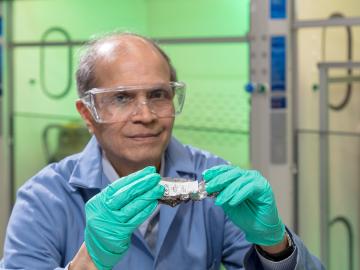
Filter News
Area of Research
- (-) Biology and Environment (73)
- (-) Materials (125)
- Advanced Manufacturing (5)
- Biological Systems (1)
- Building Technologies (1)
- Computational Engineering (1)
- Computer Science (4)
- Electricity and Smart Grid (1)
- Energy Science (132)
- Energy Sciences (2)
- Fuel Cycle Science and Technology (1)
- Fusion and Fission (24)
- Fusion Energy (8)
- Isotope Development and Production (1)
- Isotopes (19)
- Materials Characterization (2)
- Materials for Computing (5)
- Materials Under Extremes (1)
- National Security (37)
- Neutron Science (64)
- Nuclear Science and Technology (24)
- Nuclear Systems Modeling, Simulation and Validation (2)
- Quantum information Science (3)
- Supercomputing (111)
News Type
News Topics
- 3-D Printing/Advanced Manufacturing (11)
- Advanced Reactors (2)
- Artificial Intelligence (5)
- Big Data (8)
- Bioenergy (22)
- Biology (28)
- Biomedical (10)
- Biotechnology (6)
- Buildings (3)
- Chemical Sciences (19)
- Clean Water (4)
- Composites (3)
- Computer Science (20)
- Coronavirus (11)
- Critical Materials (6)
- Cybersecurity (1)
- Energy Storage (14)
- Environment (44)
- Exascale Computing (3)
- Frontier (2)
- Fusion (2)
- Grid (3)
- High-Performance Computing (11)
- Hydropower (3)
- Irradiation (1)
- Isotopes (4)
- Machine Learning (6)
- Materials (43)
- Materials Science (39)
- Mathematics (3)
- Mercury (3)
- Microscopy (10)
- Molten Salt (2)
- Nanotechnology (17)
- National Security (3)
- Neutron Science (19)
- Nuclear Energy (7)
- Partnerships (7)
- Physics (17)
- Polymers (8)
- Quantum Computing (2)
- Quantum Science (5)
- Security (1)
- Simulation (13)
- Summit (7)
- Transportation (6)
Media Contacts

Scientists at the Department of Energy Manufacturing Demonstration Facility at ORNL have their eyes on the prize: the Transformational Challenge Reactor, or TCR, a microreactor built using 3D printing and other new approaches that will be up and running by 2023.

Research by an international team led by Duke University and the Department of Energy’s Oak Ridge National Laboratory scientists could speed the way to safer rechargeable batteries for consumer electronics such as laptops and cellphones.

With the rise of the global pandemic, Omar Demerdash, a Liane B. Russell Distinguished Staff Fellow at ORNL since 2018, has become laser-focused on potential avenues to COVID-19 therapies.

Oak Ridge National Laboratory researchers have developed a thin film, highly conductive solid-state electrolyte made of a polymer and ceramic-based composite for lithium metal batteries.

In the race to identify solutions to the COVID-19 pandemic, researchers at the Department of Energy’s Oak Ridge National Laboratory are joining the fight by applying expertise in computational science, advanced manufacturing, data science and neutron science.

Scientists at Oak Ridge National Laboratory used a focused beam of electrons to stitch platinum-silicon molecules into graphene, marking the first deliberate insertion of artificial molecules into a graphene host matrix.

Researchers at the Department of Energy’s Oak Ridge National Laboratory have used Summit, the world’s most powerful and smartest supercomputer, to identify 77 small-molecule drug compounds that might warrant further study in the fight

Three technologies and one commercialization program developed at the Department of Energy’s Oak Ridge National Laboratory have won National Technology Transfer Awards from the Federal Laboratory Consortium.

Joe Paddison, a Eugene P. Wigner Fellow at the Department of Energy’s Oak Ridge National Laboratory, believes there’s more information to be found in neutron scattering data than scientists like himself might expect.

OAK RIDGE, Tenn., Feb. 27, 2020 — Researchers at Oak Ridge National Laboratory and the University of Tennessee achieved a rare look at the inner workings of polymer self-assembly at an oil-water interface to advance materials for neuromorphic computing and bio-inspired technologies.


